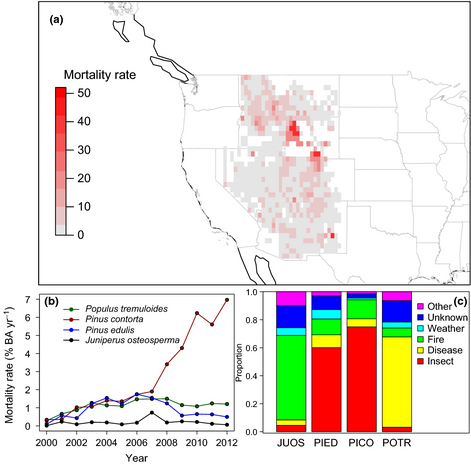A National Center for Ecological Analysis and Synthesis working group study analyzes a variety of factors contributing to forest die-offs; coauthor Naomi Tague is an Affiliate Faculty member of the Department of Geography. Julie Cohen, in an article for The UCSB Current posted June 9 with the title above goes on to state:
A combination of drought, heat and insects is responsible for the death of more than 12 million trees in California, according to a new study from UC Santa Barbara’s National Center for Ecological Analysis and Synthesis (NCEAS). Members of the NCEAS working group studying environmental factors contributing to tree mortality expect this number to increase with climate change.
The study is the first of its kind to examine the wide spectrum of interactions between drought and insects. Lead author William Anderegg, a postdoctoral researcher at the Princeton Environmental Institute, and his coauthors first devised a framework to look at the effects that each stressor can have on tree mortality and then examined interactions among them. The researchers’ findings appear in New Phytologist.
“We wanted to be able to get a sense of how these die-off patterns will shift with climate change,” explained study coauthor Naomi Tague, an associate professor at UCSB’s Bren School of Environmental Science & Management. “Are there huge forests that will be at higher risk of dying sooner?”
The western U.S. has been a hotspot for forest die-offs. Local economies in states like California and Colorado are highly dependent on the nature-based tourism and recreation provided by forests, which offer a scenic backdrop to the skiing, fishing and backpacking opportunities that draw so many people to live and play in the West. But lingering drought, rising temperatures and outbreaks of tree-killing pests such as bark beetles have spurred an increase in widespread tree mortality — especially within the past decade.
“Very often both drought and insects together are responsible for tree mortality,” explained Anderegg, “but there are several good examples of trees dying because of one impact and not the other. We’ve worked to detail the spectrum of interactions between drought and insects and examine how they go hand in hand to affect tree die-offs.”
Forest mortality has also been shown to impact everything from real estate to clean water. Property values in Colorado plummeted after swaths of coniferous forests were damaged by pine beetle infestations. Water purification services provided by forests continue to be disrupted when hectares of forests are lost to pests and drought. What’s more, forest die-off events are projected to increase in frequency and severity in the coming decades.
“If we want to account for forest die-off events at local and global scales, we need some way of estimating how often they are likely to occur,” Tague said. “We’re putting together the pieces of how climate conditions can affect that mortality and how to identify the specific stressors that cause it.”
The study’s framework is a first step toward developing the tools that resource managers need to better predict the impacts of climate change on forests. Scientists and forest specialists are now tasked not only with determining what conditions prompt tree mortality but also how they will shape forested landscapes in the years to come. Being able to predict forest mortality in a changing climate is key to conservation and land use planning.
“Ultimately, forests are a critical part of western U.S. landscapes and state economies,” Anderegg said. “They are also a canary in the coal mine for climate change. These massive forest die-offs that we are starting to see are a sign that climate change is already having major impacts in our backyard.”






